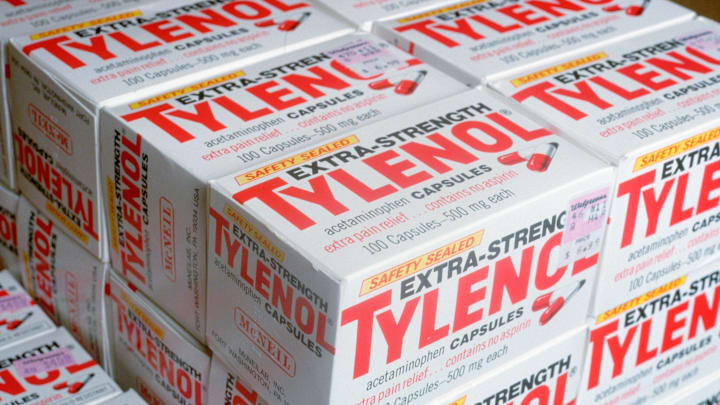Two days before Halloween in 1982, a 28-year-old Long Island resident named Frank Comunale reportedly sunk his teeth into a Cadbury Carmello candy bar and immediately felt a pinch. Pulling the candy out, he noticed that a straight pin had been inserted into it, cutting his cheek.
That same day, a group of schoolchildren in Somerdale, New Jersey were hospitalized after ingesting phencyclidine, also known as PCP or angel dust. It had been sprinkled over the Tootsie Rolls that were available at a school party.
In Nashua, New Hampshire, a man was arrested over suspicion that he had been trying to insert broken glass into an apple. In Ottawa, lye dust was reported in chewing gum. Local and national media blazed with reports over cities and communities in hysterics over what appeared to be an epidemic of product tampering.
In light of these threats—some real, many more imagined—parents and officials took drastic action. All across the country, trick-or-treating was being banned or severely restricted. Candy and costume sales plummeted. Conservative religious pundits seized the opportunity to rally against the holiday.
As some very disappointed children looked on, the adults were in the process of canceling Halloween.
There had long been fear on the part of parents and guardians over product tampering for trick-or-treating. Tradition called for them to trust strangers who deposited candy or apples into their child’s bag. Outside their immediate circle of trusted neighbors, there was suspicion that the odd or eccentric homeowner three blocks away might use Halloween as an opportunity to sicken solicitors.
In truth, there had been only a very few confirmed cases of Halloween candy poisoning, with the most infamous coming in 1974. That was the year a man named Ronald O’Bryan slipped poison into his own son’s candy, hoping to collect on an insurance payout by blaming some sinister stranger. To bolster his case, he even tried to poison the Pixy Stix of his daughter and their friends. They wound up not eating them; his son, Timothy, did. He died later that night.
O’Bryan was caught, tried, convicted, and eventually executed for the crime, lending credence to the idea that candy could be a source of victimization. But it wasn’t until seven people died in Chicago in late September 1982 that Halloween hysteria reached new heights.
In Chicago, packages of Tylenol found on store shelves had been opened and laced with cyanide. The tampering killed seven people and led to a national concern over whether the perpetrator would strike again or whether copycats would begin an effort to create even more panic.
The Tylenol tragedy’s proximity to Halloween proved to be devastating. Stores across the country reported sales of Halloween candy were dropping by 20 to 50 percent. Sales of cheap plastic costumes by manufacturers like Ben Cooper experienced similar crashes. The economy of spooky was taking a hit.
Although several incidents appeared to be true poisoning attempts, others were fueled by the paranoia started by the Tylenol incident. In Illinois, a 9-year-old boy bit into a candy and grew fearful when he noticed a metal shard embedded in it. Closer examination revealed it was one of the boy's fillings. In Los Angeles, a stadium of high school football attendees seemed to fall ill at almost precisely the same time, with 126 shuttled to an area hospital. Only three were physically sick, leading authorities to call it a case of mass hysteria.
City officials in Vineland, New Jersey weren’t taking chances. Mayor Patrick Fiorilli canceled Halloween outright, prohibiting anyone from soliciting candy door-to-door on October 31. Suburban areas in Ohio, Pennsylvania, Illinois, and Massachusetts followed suit. Those that didn’t encouraged hospitals to provide X-ray equipment so parents could screen candy for metal objects. In Chicago, the epicenter of the panic, a million leaflets were distributed with a list of Halloween safety tips.
As one 9-year-old boy told his father, as reported by the United Press International: “I'm not going trick-or-treating this year because they're putting cyanide in the candy.”
No one was ever charged with the 1982 murders. And as the Tylenol story began to fade from view, outright prohibitions on celebrating Halloween disappeared. But through the 1980s, the holiday had never quite regained its sense of fun or popularity. Costume makers specializing in cheap goods went out of business, putting an end to the kind of sharp plastic masks and baggy coveralls that once dotted city streets.
Halloween survived by evolving. Candy makers that once used tiny air holes in packaging began making sealed bags. As parents fretted over strangers, they began to host private parties in greater numbers. With costumes seen up close, demand grew for more durable and elaborate outfits. Adults who got a disguise in order to host kid parties began to have a desire to host one for adults, too. In the early part of the decade, adult costumes made up only 10 percent of the market. By 1989, the number was up to approximately 50 percent. Costume makers who had nearly gone out of business were now enjoying record profits by catering to a brand-new demographic. While the tampering had nearly destroyed Halloween, it was also indirectly responsible for reviving it.
